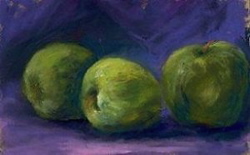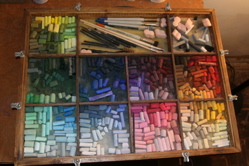The Classroom
Materials: Pastels
 Soft pastel is a dry medium created by mixing pure color pigment with a small amount of liquid binder. Common binders such as gum arabic, gum tragacanth, or methyl cellulose are added to the dry ingredient until it's a dough-like consistency. The pigment dough is then formed into a stick and allowed to dry.
Soft pastel is a dry medium created by mixing pure color pigment with a small amount of liquid binder. Common binders such as gum arabic, gum tragacanth, or methyl cellulose are added to the dry ingredient until it's a dough-like consistency. The pigment dough is then formed into a stick and allowed to dry.
Soft pastels have been around since the fifteenth century, and the general term "pastel" will usually indicate the piece was rendered using soft pastel. Oil pastels are a twentieth century invention, and are usually designated as such. Although identical pigments may be used, their binders are completely different. Consisting of wax, mineral oil, glycerol, or stearic acid, oil pastels remain malleable because their binders are nondrying.
The consistency of a pastel is determined by the type of binder used, and the amount added to the pigment. Pastels are available in varying degrees of hardness from different manufacturers. Softer brands contain very little binder while the harder brands will contain less pigment.
Pastels can be blended, but unlike paint cannot be mixed into new colors. Pure color pigments are lightened or darkened before they're formed, and hundreds of colors and shades are available.

Soft pastel can be blended with a variety of tools. Fingers seem to be the most common, as they are readily available and clean up easily. Blending oil pastels usually requires the addition of linseed oil or turpentine, and a brush or palette knife is often used.
Specialized tools made for blending include tortillions, chamois cloth, paint brushes, and blenders made especially for pastels. Other popular items include Viva paper towl, Q-Tips, make-up sponges, and even packing peanuts. However, many pastellists do little if any blending at all, preferring the vibrancy of the pure pigments layered onto the paper.
A rigid glazing is necessary to protect the surface of a completed pastel. Soft pastel can smear even after fixative is applied, and pliable oil pastel can be easily scratched. In order to prevent contact between the pastel and the glass or acrylic, a spacer or matboard is used.
Soft pastel artwork can be easily stored in a portfolio by placing Glassine paper between pastels. Foamcore is an economical alternative to a portfolio, and portfolios made especially for pastel artwork are available from Dakota Pastels.